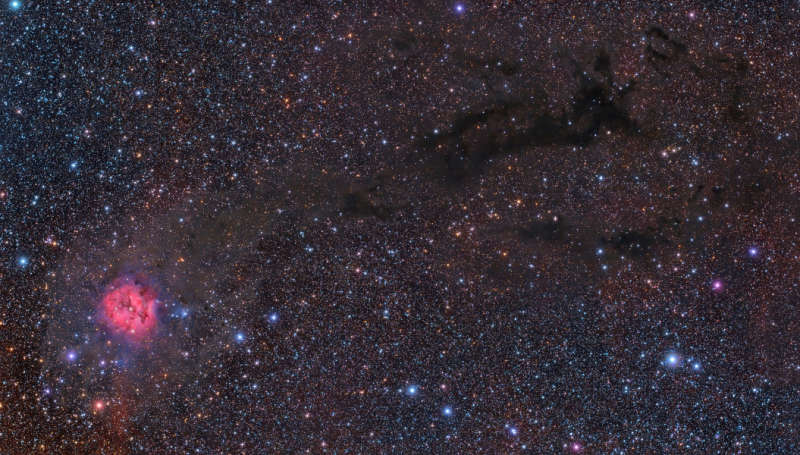Credit & Copyright: Federico Pelliccia
Explanation:
In this crowded
starfield covering over 2 degrees within the high flying
constellation
Cygnus,
the eye is drawn to the Cocoon Nebula.
A compact star forming region,
the cosmic Cocoon
punctuates a long trail of obscuring interstellar dust clouds.
Cataloged as IC 5146, the
nebula is nearly 15 light-years wide, located
some 4,000 light years away.
Like other star forming regions, it stands out
in red, glowing, hydrogen gas
excited by the young, hot stars
and blue, dust-reflected starlight
at the edge of an otherwise invisible
molecular cloud.
In fact, the bright star near the center of this nebula is likely
only a few hundred thousand years old, powering the nebular glow as it
clears out
a cavity in the molecular
cloud's star forming dust and gas.
But the long dusty filaments that appear dark in this visible
light image are themselves hiding stars in the process of formation
that can be seen
seen at infrared wavelengths.
1999 2000 2001 2002 2003 2004 2005 2006 2007 2008 2009 2010 2011 2012 2013 2014 2015 2016 2017 2018 2019 2020 2021 2022 2023 2024 2025 |
Yanvar' Fevral' Mart Aprel' Mai Iyun' Iyul' Avgust Sentyabr' Oktyabr' Noyabr' Dekabr' |
NASA Web Site Statements, Warnings, and Disclaimers
NASA Official: Jay Norris. Specific rights apply.
A service of: LHEA at NASA / GSFC
& Michigan Tech. U.
|
Publikacii s klyuchevymi slovami:
star formation - molecular cloud - tumannost' Kokon - zvezdoobrazovanie
Publikacii so slovami: star formation - molecular cloud - tumannost' Kokon - zvezdoobrazovanie | |
Sm. takzhe:
Vse publikacii na tu zhe temu >> | |
